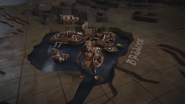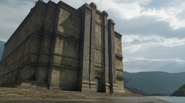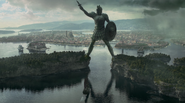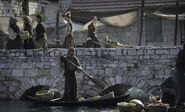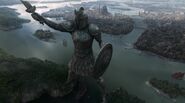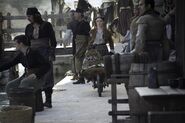Tags: Visual edit apiedit |
Tags: Visual edit apiedit |
||
| (14 intermediate revisions by 2 users not shown) | |||
| Line 26: | Line 26: | ||
==History== |
==History== |
||
| − | + | Of the nine Free Cities in western Essos, Braavos is the only one that was not originally a colony of the [[Valyrian Freehold]]. The city was, in fact, founded by a large group of [[Slavery|slaves]], who overpowered their Valyrian captors and took control of the ships that were transporting them. Knowing they would be severely punished for such an act of rebellion, the slaves sought a refuge as far away from the Freehold as possible. Braavosi histories claim that a group of wise women- priestesses who followed the religion of the [[Moonsingers]]- prophesied where they would find sanctuary; in a distant lagoon surrounded by pine-clad slopes, where the thick fog would help conceal the refugees from passing dragonriders. It was to just such a place that the refugees ultimately arrived, and their city began to expand across the many islands and mudflats that dotted the lagoon. |
|
| − | For more than a century, Braavos remained hidden from the world |
+ | For more than a century, Braavos remained hidden from the world: To disguise their stolen Valyrian ships, the refugees made use of a dye derived from a local species of snail and stained the hulls and sails of the ships a deep purple (a practice that the Braavosi continue to use on their ships in the present-day). Fearing recapture, the founders of the city took great pains to keep its existence secret, presenting false information to any outsiders when questioned about their homeland. Eventually, the city's elected leader- known as the Sealord- sent ships across the world to proclaim the existence of Braavos, an event known as the Unmasking and celebrated every year since with ten days of feasting and revelry. After the [[Doom of Valyria]], Braavos rose to even greater prominence, becoming a major trade and banking center. The [[Iron Bank of Braavos]] is the greatest single repository of wealth in the [[known world]], and everyone from princes to merchants have frequented it to request loans of gold. |
==Geography== |
==Geography== |
||
| − | Braavos is located |
+ | Braavos is located at the northwestern-most point of the continent of [[Essos]], where the [[Narrow Sea]] to the west meets the [[Shivering Sea]] to the north. The city is spread across hundreds of tiny islands in the lagoon, connected by stone bridges<ref>[http://viewers-guide.hbo.com/game-of-thrones/season1/#!/locations/braavos/ HBO viewers guide, season 1 map, Braavos entry]</ref><ref name="Braavos VG">[http://viewers-guide.hbo.com/game-of-thrones/season2/#!/locations/braavos/ HBO viewers guide, season 2 map, Braavos entry]</ref> and a vast network of canals. |
As well as the city itself, the rulers of Braavos also control the surrounding lagoon and [[Braavosian Coastlands|a strip of the coastline]] southwards towards [[Pentos]].<ref>[http://viewers-guide.hbo.com/game-of-thrones/season1/#!/locations/braavos/ HBO viewers guide, season 1 map, Braavos entry]</ref><ref name="Braavos VG">[http://viewers-guide.hbo.com/game-of-thrones/season2/#!/locations/braavos/ HBO viewers guide, season 2 map, Braavos entry]</ref> |
As well as the city itself, the rulers of Braavos also control the surrounding lagoon and [[Braavosian Coastlands|a strip of the coastline]] southwards towards [[Pentos]].<ref>[http://viewers-guide.hbo.com/game-of-thrones/season1/#!/locations/braavos/ HBO viewers guide, season 1 map, Braavos entry]</ref><ref name="Braavos VG">[http://viewers-guide.hbo.com/game-of-thrones/season2/#!/locations/braavos/ HBO viewers guide, season 2 map, Braavos entry]</ref> |
||
==Locations in the city== |
==Locations in the city== |
||
| − | |||
| − | The city spans hundreds of tiny islands connected by small stone bridges.<ref>[http://viewers-guide.hbo.com/game-of-thrones/season1/#!/locations/braavos/ HBO viewers guide, season 1 map, Braavos entry]</ref><ref name="Braavos VG">[http://viewers-guide.hbo.com/game-of-thrones/season2/#!/locations/braavos/ HBO viewers guide, season 2 map, Braavos entry]</ref> |
||
| − | |||
| − | |||
===Buildings=== |
===Buildings=== |
||
| Line 52: | Line 48: | ||
*Ragman Harbor |
*Ragman Harbor |
||
*Moonsinger Lane |
*Moonsinger Lane |
||
| + | *The Long Canal |
||
==Government== |
==Government== |
||
| Line 57: | Line 54: | ||
==Culture== |
==Culture== |
||
| + | |||
| + | More than any of the other Free Cities, Braavos is renowned for its ethnic diversity and religious tolerance. Since the founders of the city came from many lands and worshiped many different gods, it was decreed that all faiths would be honored and that no one religion would be elevated above any other, although some faiths have more devotees- and thus larger temples- than others (the Moonsingers and the [[Lord of Light]] being outstanding examples). |
||
| + | |||
| + | Another defining trait of Braavosi culture is its hatred of slavery, a direct relic of the city's founding. The first law of Braavos- engraved on the arch that rises above the Long Canal- decrees that no man, woman, or child in the city is ever to be made a slave. In fact, Braavos is one of the very few places in Essos where slavery is not practiced (by contrast, [[Volantis]] contains five slaves for every free man). |
||
Braavosi are revered seafarers and [[Bravos|swordsmen]].<ref name="Braavos VG" /> |
Braavosi are revered seafarers and [[Bravos|swordsmen]].<ref name="Braavos VG" /> |
||
| Line 102: | Line 103: | ||
==Behind the scenes== |
==Behind the scenes== |
||
[[File:Braavos wideshot.jpg|thumb|A wider view of the entire city of Braavos]] |
[[File:Braavos wideshot.jpg|thumb|A wider view of the entire city of Braavos]] |
||
| − | The architecture and costuming of Braavos, which first |
+ | The architecture and costuming of Braavos, which first appeared on-screen in Season 4, were heavily inspired by the Dutch Golden Age of the 16th and 17th centuries: |
:[[Frank Doelger]] (Executive Producer) "Once we decided we were using the Netherlands in the 16th and 17th century as [[Wikipedia:Dutch Baroque architecture|the model for the buildings]] of Braavos, Michele then picked up on that, and designed the costumes for Braavos along the same lines." |
:[[Frank Doelger]] (Executive Producer) "Once we decided we were using the Netherlands in the 16th and 17th century as [[Wikipedia:Dutch Baroque architecture|the model for the buildings]] of Braavos, Michele then picked up on that, and designed the costumes for Braavos along the same lines." |
||
| Line 110: | Line 111: | ||
:[[D.B. Weiss]] (Executive Producer): "...From the moment we read about the Iron Bank, and [[Tycho Nestoris]] the representative of the [[Iron Bank of Braavos|Iron Bank]], we loved it because it was such an atypical element - banking doesn't really factor into most High Fantasy. But it's very modern, I mean the lines are very clean and Dutch Protestant, and the way they dress is inspired by the [[Wikipedia:Dutch Golden Age|Dutch Golden Age]], and they're a bit more advanced than most of the people in Westeros - which is perhaps why they're in charge of everything."<ref>[https://www.youtube.com/watch?v=Pk00ppQ5nNw Game of Thrones - Silk, Leather & Chainmail: Costumes of Season 4]</ref> |
:[[D.B. Weiss]] (Executive Producer): "...From the moment we read about the Iron Bank, and [[Tycho Nestoris]] the representative of the [[Iron Bank of Braavos|Iron Bank]], we loved it because it was such an atypical element - banking doesn't really factor into most High Fantasy. But it's very modern, I mean the lines are very clean and Dutch Protestant, and the way they dress is inspired by the [[Wikipedia:Dutch Golden Age|Dutch Golden Age]], and they're a bit more advanced than most of the people in Westeros - which is perhaps why they're in charge of everything."<ref>[https://www.youtube.com/watch?v=Pk00ppQ5nNw Game of Thrones - Silk, Leather & Chainmail: Costumes of Season 4]</ref> |
||
| − | When the Dutch Republic achieved independence after the Eighty Years War ended, |
+ | When the Dutch Republic achieved independence after the [https://en.wikipedia.org/wiki/Eighty_Years%27_War Eighty Years War] ended, the resulting government was a non-hereditary general assembly, at least in theory; in practice it was dominated by oligarchical merchant families. In any case, this led to a strong anti-monarchist sentiment during the Dutch Golden Age, a time espousing egalitarian values. Architectural designs from the period have a marked emphasis on sobriety and restraint - in contrast with wealthy kings and nobles who were each trying to outdo each other with increasingly opulent displays of grandeur. In many ways this matches how Braavosi society is described in the novels: founded by a diverse mixture of escaped slaves from the Valyrian Freehold, Braavos is strongly opposed to the slave trade, and has no hereditary nobles or kings. Like the Dutch Republic, Braavosi politics are largely dominated by wealthy merchant-princes and bankers. |
| − | Physically, due to its many canals and romance culture vaguely similar to medieval Italian city-states, Braavos in the novels is vaguely similar to real-life [[Wikipedia:Venice|Venice]]. However, in terms of climate and weather, it is |
+ | Physically, due to its many canals and romance culture vaguely similar to medieval Italian city-states, Braavos in the novels is vaguely similar to real-life [[Wikipedia:Venice|Venice]]. However, in terms of climate and weather, it is the northernmost of the Free Cities (at the same latitude as [[The Eyrie|the Eyrie]] in Westeros), and is noted for having cooler temperatures with mists rolling in off the water - more akin to northern European cities like Amsterdam. The giant statue known as the Titan of Braavos is analogous to that of the ancient Greek Colossus of Rhodes. |
Indeed, Production Designer [[Deborah Riley]] said in a Season 4 featurette: "David and Dan had always said that perhaps an inspiration for Braavos could be Venice. And the thing that I think was quite exciting about Braavos (in "[[The Laws of Gods and Men]]") was being able to show wealth, but being able to show it through an austerity, through the notion that less is more."<ref>[http://www.makinggameofthrones.com/production-diary/the-titan-of-braavos]</ref> |
Indeed, Production Designer [[Deborah Riley]] said in a Season 4 featurette: "David and Dan had always said that perhaps an inspiration for Braavos could be Venice. And the thing that I think was quite exciting about Braavos (in "[[The Laws of Gods and Men]]") was being able to show wealth, but being able to show it through an austerity, through the notion that less is more."<ref>[http://www.makinggameofthrones.com/production-diary/the-titan-of-braavos]</ref> |
||
==In the books== |
==In the books== |
||
| − | In the ''[[A Song of Ice and Fire]]'' novels, Braavos lies at the northwestern-most |
+ | In the ''[[A Song of Ice and Fire]]'' novels, Braavos lies at the northwestern-most point of the continent of [[Essos]], roughly due east of [[the Vale of Arryn]] in [[Westeros]]. Braavos is the only one of the nine Free Cities which is not a former colony of the [[Valyrian Freehold]]. The city was founded by galley slaves after they staged a mutiny and killed their Valyrian overseers. Directed by the Moonsingers, they sailed as far north as they could in the Narrow Sea in search of a refuge. They established the Secret City of Braavos and kept its location secret for over four centuries, accepting other refugees and escaped slaves in the process. Because of the nature of its founding, Braavos does not keep slaves, does not like to do business with those who keep slaves, and frequently uses its military and economic power to encourage other states to give up slavery. After the [[Doom of Valyria]] four hundred years ago Braavos revealed itself to the world, and as the other Free Cities were left in chaos for decades after the Doom, Braavos rose to become the most powerful of the Free Cities. Due to its unique origin, Braavos is sometimes referred to as the Bastard Daughter of Valyria. |
Because the Valyrians took slaves from across the vast reaches of the continent of Essos, its slave population was very diverse. Due to its origins as a refuge for slaves escaping from Valyria, Braavos is ethnically and culturally very diverse, with much more of a "cosmopolitan" and polyglot society than even the other Free Cities. There is no one majority religion in Braavos as a result: worshipers of all major religions may be found there (even the Faith of the Seven and the Lord of Light have at least small temples in Braavos), as well as numerous minor local religions. As a result of this diversity, there is no set "Braavosi ethnicity" or set of physical features. This is in contrast with some of the other Free Cities, such as Myr (whose inhabitants tend to have dark features and olive-skin) or Lys (whose inhabitants have classic Valyrian looks of pale skin, blue eyes, and blonde to white hair). |
Because the Valyrians took slaves from across the vast reaches of the continent of Essos, its slave population was very diverse. Due to its origins as a refuge for slaves escaping from Valyria, Braavos is ethnically and culturally very diverse, with much more of a "cosmopolitan" and polyglot society than even the other Free Cities. There is no one majority religion in Braavos as a result: worshipers of all major religions may be found there (even the Faith of the Seven and the Lord of Light have at least small temples in Braavos), as well as numerous minor local religions. As a result of this diversity, there is no set "Braavosi ethnicity" or set of physical features. This is in contrast with some of the other Free Cities, such as Myr (whose inhabitants tend to have dark features and olive-skin) or Lys (whose inhabitants have classic Valyrian looks of pale skin, blue eyes, and blonde to white hair). |
||
Revision as of 13:44, 29 April 2016
- "Braavos is the strangest, a city erected not by the Freehold, but against it. A labyrinth of illusion and deceit to hide the refugees from Valyria's slave-lords. After the Doom, the city emerged from the shadows to become one of the greatest banking centers in the world."
- ―Ser Jorah Mormont discusses the Free Cities.

Bravos walk the wharves of Braavos
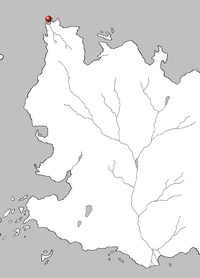
Map showing the location of Braavos on the continent of Essos.
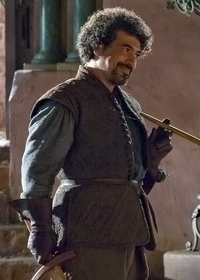
Syrio Forel, First Sword of Braavos.
Braavos is one of the Free Cities located to the east of Westeros. It is the northern-most, the richest, and arguably the most powerful of the Free Cities.
A giant statue known as the Titan of Braavos guards the harbor entrance to the city.
The people of Braavos are known as Braavosi.
History
Of the nine Free Cities in western Essos, Braavos is the only one that was not originally a colony of the Valyrian Freehold. The city was, in fact, founded by a large group of slaves, who overpowered their Valyrian captors and took control of the ships that were transporting them. Knowing they would be severely punished for such an act of rebellion, the slaves sought a refuge as far away from the Freehold as possible. Braavosi histories claim that a group of wise women- priestesses who followed the religion of the Moonsingers- prophesied where they would find sanctuary; in a distant lagoon surrounded by pine-clad slopes, where the thick fog would help conceal the refugees from passing dragonriders. It was to just such a place that the refugees ultimately arrived, and their city began to expand across the many islands and mudflats that dotted the lagoon.
For more than a century, Braavos remained hidden from the world: To disguise their stolen Valyrian ships, the refugees made use of a dye derived from a local species of snail and stained the hulls and sails of the ships a deep purple (a practice that the Braavosi continue to use on their ships in the present-day). Fearing recapture, the founders of the city took great pains to keep its existence secret, presenting false information to any outsiders when questioned about their homeland. Eventually, the city's elected leader- known as the Sealord- sent ships across the world to proclaim the existence of Braavos, an event known as the Unmasking and celebrated every year since with ten days of feasting and revelry. After the Doom of Valyria, Braavos rose to even greater prominence, becoming a major trade and banking center. The Iron Bank of Braavos is the greatest single repository of wealth in the known world, and everyone from princes to merchants have frequented it to request loans of gold.
Geography
Braavos is located at the northwestern-most point of the continent of Essos, where the Narrow Sea to the west meets the Shivering Sea to the north. The city is spread across hundreds of tiny islands in the lagoon, connected by stone bridges[1][2] and a vast network of canals.
As well as the city itself, the rulers of Braavos also control the surrounding lagoon and a strip of the coastline southwards towards Pentos.[3][2]
Locations in the city
Buildings
Streets, squares, and canals
- Ragman Lane
- Ragman Harbor
- Moonsinger Lane
- The Long Canal
Government
Braavos is ruled by the Sealord, an elected position.
Culture
More than any of the other Free Cities, Braavos is renowned for its ethnic diversity and religious tolerance. Since the founders of the city came from many lands and worshiped many different gods, it was decreed that all faiths would be honored and that no one religion would be elevated above any other, although some faiths have more devotees- and thus larger temples- than others (the Moonsingers and the Lord of Light being outstanding examples).
Another defining trait of Braavosi culture is its hatred of slavery, a direct relic of the city's founding. The first law of Braavos- engraved on the arch that rises above the Long Canal- decrees that no man, woman, or child in the city is ever to be made a slave. In fact, Braavos is one of the very few places in Essos where slavery is not practiced (by contrast, Volantis contains five slaves for every free man).
Braavosi are revered seafarers and swordsmen.[2]
Unlike Westerosi nobility, wealthy and powerful Braavosi favor wearing dark colors.[4]
Gallery
Notable Braavosi
- Syrio Forel, former First Sword of Braavos, resident in King's Landing. Believed to have been killed by Ser Meryn Trant of the Kingsguard.
- "Jaqen H'ghar", a member of the Faceless Men.
- Tycho Nestoris, a representative of the Iron Bank of Braavos.
- Ternesio Terys, captain of the Titan's Daughter.
Recent Events
Season 1
Lord Eddard Stark hires Syrio Forel of Braavos as a sword tutor for his daughter, Arya. Syrio tells Arya that he was the First Sword of the city for nine years.[5] Syrio later says that the First Sword of Braavos never runs from a fight, no matter how hopeless.[6]
Season 2
Jaqen H'ghar offers three deaths to Arya Stark as payment for her having saved his life and the lives of two other men. After Arya uses her third death to escape from Harrenhal, she meets Jaqen on the road, who tells and shows her that he is one of the Faceless Men of Braavos and invites her to follow him back there. When Arya grudgingly declines, Jaqen gives her a coin and tells her to show it to a Braavosi and recite the words "Valar Morghulis" should she ever decide to visit Braavos.
Season 3
Tyrion Lannister learns after becoming Master of Coin that the Iron Throne is deeply in debt to the Iron Bank of Braavos.[7]
Season 4
King Stannis Baratheon and Ser Davos Seaworth visit Braavos to treat with the Iron Bank. The Bank initially refuses to financially back Stannis, but changes their mind after Davos points out that, apart from the aged Tywin Lannister, none of the members of House Lannister are reliable trading or banking partners likely to make good on their debts, whereas Stannis is not only in his prime and a proven battle commander, but also a man who fulfills his promises. The Iron Bank then agrees to help fund Stannis' war effort. Davos then recruits Salladhor Saan, who is in Braavos at the time.[8]
Arya Stark approaches a ship's captain (Ternesio Terys) wanting to book passage to the North. He turns her down, saying that he is actually bound for his home city of Braavos. Remembering the iron coin and instructions given to her by Jaqen H'ghar, Arya hands Terys the coin and says valar morghulis. Startled, he responds valar dohaeris and promises that she will have a cabin.[9]
Season 5
Arya marvels at the Titan of Braavos as Captain Terys's ship sails beneath it. She later observes the massive city, wealthy yet somehow austere, as Terys rows her across the lagoon to the House of Black and White. After being refused entry, Arya spends a few days as a street urchin in one of Braavos's many markets.[10]
In a Small Council meeting Mace reveals that the Iron Bank has called in one tenth of the Crown's debts. When asked by Cersei, Mace admits that the Crown can not pay back more than half of the demanded sum. When Mace offers that House Tyrell could lend the needed money to the Iron Throne, Cersei politely refuses, stating that the Tyrells have already given too much. She then tasks Mace with personally travelling to Braavos to negotiate better terms with the Iron Bank. She also tells Mace that the king, concerned for his father-in-law's safety, has assigned Ser Meryn Trant to escort Mace to Braavos. Mace and Meryn leave immediately, prompting Pycelle to state that the Small Council grows smaller and smaller.[11]
After arriving in Braavos, he is greeted by Tycho Nestoris who welcomes him in the name of the Iron Bank. Arriving at the Iron Bank, Mace admires the facade of the enormous building, stating that the men of the Iron Bank are the world's best gamblers much to Tycho Nestoris' disapproval. After an unspecified time of negotiation, Tycho tries to bid farewell to Mace (whom he clearly dislikes due to his bumbling behavior), but Mace does not realize this and continues plaguing Tycho on the way to the docks, loudly singing.
Behind the scenes
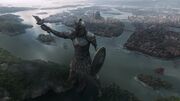
A wider view of the entire city of Braavos
The architecture and costuming of Braavos, which first appeared on-screen in Season 4, were heavily inspired by the Dutch Golden Age of the 16th and 17th centuries:
- Frank Doelger (Executive Producer) "Once we decided we were using the Netherlands in the 16th and 17th century as the model for the buildings of Braavos, Michele then picked up on that, and designed the costumes for Braavos along the same lines."
- Michele Clapton (Costume designer): "I quite like the idea that banking is a dirty business. Once they come into the bank, they put the (sable?) on, because it's where they're working. And the men are in these very pleated skirts, and metalic ruffs [ruffles].
- D.B. Weiss (Executive Producer): "...From the moment we read about the Iron Bank, and Tycho Nestoris the representative of the Iron Bank, we loved it because it was such an atypical element - banking doesn't really factor into most High Fantasy. But it's very modern, I mean the lines are very clean and Dutch Protestant, and the way they dress is inspired by the Dutch Golden Age, and they're a bit more advanced than most of the people in Westeros - which is perhaps why they're in charge of everything."[12]
When the Dutch Republic achieved independence after the Eighty Years War ended, the resulting government was a non-hereditary general assembly, at least in theory; in practice it was dominated by oligarchical merchant families. In any case, this led to a strong anti-monarchist sentiment during the Dutch Golden Age, a time espousing egalitarian values. Architectural designs from the period have a marked emphasis on sobriety and restraint - in contrast with wealthy kings and nobles who were each trying to outdo each other with increasingly opulent displays of grandeur. In many ways this matches how Braavosi society is described in the novels: founded by a diverse mixture of escaped slaves from the Valyrian Freehold, Braavos is strongly opposed to the slave trade, and has no hereditary nobles or kings. Like the Dutch Republic, Braavosi politics are largely dominated by wealthy merchant-princes and bankers.
Physically, due to its many canals and romance culture vaguely similar to medieval Italian city-states, Braavos in the novels is vaguely similar to real-life Venice. However, in terms of climate and weather, it is the northernmost of the Free Cities (at the same latitude as the Eyrie in Westeros), and is noted for having cooler temperatures with mists rolling in off the water - more akin to northern European cities like Amsterdam. The giant statue known as the Titan of Braavos is analogous to that of the ancient Greek Colossus of Rhodes.
Indeed, Production Designer Deborah Riley said in a Season 4 featurette: "David and Dan had always said that perhaps an inspiration for Braavos could be Venice. And the thing that I think was quite exciting about Braavos (in "The Laws of Gods and Men") was being able to show wealth, but being able to show it through an austerity, through the notion that less is more."[13]
In the books
In the A Song of Ice and Fire novels, Braavos lies at the northwestern-most point of the continent of Essos, roughly due east of the Vale of Arryn in Westeros. Braavos is the only one of the nine Free Cities which is not a former colony of the Valyrian Freehold. The city was founded by galley slaves after they staged a mutiny and killed their Valyrian overseers. Directed by the Moonsingers, they sailed as far north as they could in the Narrow Sea in search of a refuge. They established the Secret City of Braavos and kept its location secret for over four centuries, accepting other refugees and escaped slaves in the process. Because of the nature of its founding, Braavos does not keep slaves, does not like to do business with those who keep slaves, and frequently uses its military and economic power to encourage other states to give up slavery. After the Doom of Valyria four hundred years ago Braavos revealed itself to the world, and as the other Free Cities were left in chaos for decades after the Doom, Braavos rose to become the most powerful of the Free Cities. Due to its unique origin, Braavos is sometimes referred to as the Bastard Daughter of Valyria.
Because the Valyrians took slaves from across the vast reaches of the continent of Essos, its slave population was very diverse. Due to its origins as a refuge for slaves escaping from Valyria, Braavos is ethnically and culturally very diverse, with much more of a "cosmopolitan" and polyglot society than even the other Free Cities. There is no one majority religion in Braavos as a result: worshipers of all major religions may be found there (even the Faith of the Seven and the Lord of Light have at least small temples in Braavos), as well as numerous minor local religions. As a result of this diversity, there is no set "Braavosi ethnicity" or set of physical features. This is in contrast with some of the other Free Cities, such as Myr (whose inhabitants tend to have dark features and olive-skin) or Lys (whose inhabitants have classic Valyrian looks of pale skin, blue eyes, and blonde to white hair).
The city sprawls across a hundred islands in a vast lagoon. The nearby mainland is mostly marshland, while the seaward sides of the city are protected by tall, mountainous islands which form a semi-circle around the city. There is only one channel large and deep enough to accommodate ocean-going ships. This channel is defended by a massive statue called the Titan of Braavos, which serves as landmark, lighthouse and defensive fortification. Just beyond the Titan lies a vast shipyard called the Arsenal, which is capable of assembling a war galley out of local materials in just a day. The city proper lies beyond.
The city itself consists of a hundred unwalled islands linked by bridges and separated by water, either natural channels or canals. Several parts of the city have sunk over the years, although the tops of the buildings are still visible emerging about the waves. The city is served by two immense harbors, the Ragman's Harbor in the west were foreign ships are berthed and the Purple Harbor in the north, used by locals. All ships have to submit to inspection from officials at the Chequy Port before being directed to a berth.
The city is ruled by the Sealord, though various nobles have a say in the city's affairs. The city is religiously tolerant, with many temples to many deities (including the Westeros Faith of the Seven) located on the Isle of the Gods. A sect known as the Moonsingers are the most popular religion in Braavos, however. The city has a strong military force, consisting of the largest fleet of ships on the Narrow Sea and the resources necessary to hire large armies of mercenaries and freeriders very quickly. The city also has a powerful banking institution, the Iron Bank, which holds the debts of many other governments (including the Iron Throne of Westeros), furthering Braavosi influence and power. Currently, the Iron Bank of Braavos is bigger than the banks of all the other Free Cities put together, and plays a major role in financial transactions across both Essos and Westeros.
Braavos is strongly allied to the Free City of Pentos, located further south along the coast. The Braavosi influence has seen Pentos outlaw slavery within the city (though very wealthy Pentoshi like Illyrio Mopatis privately flout this with their "servants").
At the time of the War of the Five Kings, Braavos is more or less the most powerful of the Free Cities. The Free City with the largest population is Volantis, the first colony of Valyria which used to be the most powerful. However, Volantis entered into a decline three hundred years ago after attempting and failing to conquer all of the other Free Cities. While still one of the more powerful of the group, due to its decline and internal problems supporting its large population, Volantis was edged out by Braavos as the most powerful overall. This is despite the fact that Braavos actually has a relatively small population, and physically all of Braavos could easily fit within Volantis's harbor.
The historical development of Braavos also has some loose parallels with ancient Athens. Braavos is actually located on very poor swamp lands, and does not actually produce many of its own products for export: the Braavosi economy is based on banking, and maintaining a large merchant fleet which transports goods between the different Free Cities and Westeros. The ancient Athenian historian Thucydides, writing in the fifth century B.C., pointed out that Athens was also located on lands which were actually poor relative to other parts of Greece, yet it rose to dominate much of the rest of Greece. Thucydides theorized that because Athens started out on poor lands, it wasn't a frequent target of foreign invasions, while other more wealthy cities were constantly being invaded or fighting trade wars. Thus while these other cities may have been physically richer, they could not capitalize on this raw wealth, while poor Athens enjoyed enough long-term political stability that it eventually became a major hub for the development of regional commerce. Similarly, Braavos is relatively small, and has few natural resources, but because it wasn't reliant on Valyria it enjoyed political and economic stability during the Century of Blood, the hundred years of constant civil wars between the Free Cities following the Doom of Valyria. Because Braavos was so stable, its banks and shipping became the most reliable, until it dominated commerce throughout the rest of the Free Cities.
According to the TV series official pronunciation guide developed for the cast and crew, "Braavos" is pronounced "BRA-vos ".
Locations
Braavos sprawls across a hundred small islands in the lagoon, connected by numerous bridges, while the larger islands are criss-crossed by networks of smaller canals. For this reason horses are a rare sight in the city, and small boats are fastest means of travel from one point in the city to another. There are also few trees in the city (except in gardens of the wealthy), nor is there brush and thatch to weave into roof coverings, so buildings in Braavos are typically made entirely of stone.
The only opening in the lagoon large enough for sea-going ships to enter is defended by the Titan of Braavos, to the northwest of the city. Ships that sail under the Titan and continue in a straight line will reach the main waterway through Braavos, the Long Canal, which roughly divides the city in half. The Long Canal widens out when it reaches the heart of the city, forming its own interior artificial harbor, dotted with a few smaller islands which numerous temples are located on (due to their central location), among them the House of Black and White. Large ocean-going ships cannot sail onto the Long Canal itself, due to the shallow water and numerous bridges.
Instead, two major harbors along the outer edges of Braavos service ocean-going ships: the Purple Harbor on the northern side (proceeding left after passing the Titan), and Ragman's Harbor on the western side (to the right side after passing the Titan). Only Braavosi ships are allowed to use the Purple Harbor, while foreign ships have to use Ragman's Harbor (making the latter a much more rough and dirty neighborhood).
The dozens of islets in Braavos (some natural, other made by canals) are generally gathered into four major clumps or districts, three of which touch the Long Canal. Generally, the northeast of the city near the Purple Harbor is richer, while the northwestern of the city near Ragman's Harbor is more working-class:
- One large district runs along the entire western side of the Long Canal, with Ragman's Harbor on its outer western edge. The large number of foreign sailors trafficking here make it a more rough and working class section of the city - though still prosperous and bustling with activity - Braavos has its rich and poor sections, but not a truly massive slum district comparable to Flea Bottom in King's Landing. The parts that actually border the central harbor are grander and inhabited by wealthier merchants. Arya Stark spends much of her time in this district around Ragman's Harbor (in part because she is still learning to speak Braavosi and more people in this section know the Common Tongue of Westeros).
- The eastern side of the city from the Long Canal is itself roughly bisected by the smaller Green Canal, which also leads into the central harbor. The northeastern district is the most splendid part of the city, where most of the rich and powerful live: the Purple Harbor, the Sealord's Palace, the Iron Bank of Braavos, and the Hall of Justice are all located here. Accordingly, the northeast district is noted to have the best inns, taverns, and brothels in the entire city.
- Across the Green Canal, the southeastern district of the city is less noteworthy. Like the northwestern district, the parts of this section near the inner harbor itself are inhabited by several powerful families, but south of that, the region called the "Silty Town" is described as having small and unimportant buildings.
- The southwest corner of the city doesn't even touch the Long Canal. It is not one large clump of islets but actually four smaller ones (still connected to all the others with bridges). No noteworthy locations have been described in this section of the city at all; it is probable that similar to the Silty Town on the opposite southeastern side, this district has smaller and less important buildings, with all of the major landmarks like the Iron Bank or Ragman's Harbor in the northern sections of the city.
The large aquaduct known as the Sweetwater River enters the city at the western side of the southern exit to the Long Canal. However, it only runs over the southernmost tip of the large western district, before crossing over the Long Canal into the southeastern district, then makes a long curve northwards along almost the entire length of the eastern side of the city. In the southeast district, it forms the divide between the Silty Town and more well-to-do area bordering the central harbor to the north. The aquaduct then crosses over the Green Canal, and continues all the way to near the Iron Bank itself, where it terminates at the Moon Pool.
See also
Braavos on A Wiki of Ice and Fire (spoilers from the books)
References
- ↑ HBO viewers guide, season 1 map, Braavos entry
- ↑ 2.0 2.1 2.2 HBO viewers guide, season 2 map, Braavos entry
- ↑ HBO viewers guide, season 1 map, Braavos entry
- ↑ "The Laws of Gods and Men"
- ↑ "Lord Snow"
- ↑ "The Pointy End"
- ↑ "Walk of Punishment"
- ↑ "The Laws of Gods and Men"
- ↑ "The Children"
- ↑ "The House of Black and White"
- ↑ "Sons of the Harpy"
- ↑ Game of Thrones - Silk, Leather & Chainmail: Costumes of Season 4
- ↑ [1]
Template:Regions of the Known World Template:FreeCities
Braavos | |
|---|---|
| Institutions |
Faceless Men · First Sword of Braavos · Iron Bank of Braavos · Sealord of Braavos |
| Places |
Arsenal of Braavos · House of Black and White · Isle of the Gods · Long Canal · Moon Pool · Moonsinger Lane · Palace of Justice · Ragman Harbor · Ragman Lane · Red Temple of Braavos · Salty Town · Sealord's Palace · Sheelba Square · Sweetwater River · Temple of the Moonsingers · Titan of Braavos |
| Culture | |

